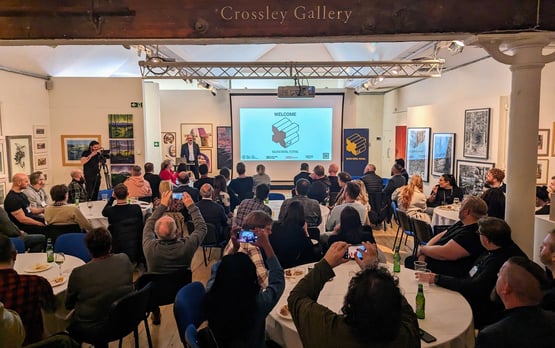Community
Working towards composable commerce with Missguided [Event]
20 October 2021 • 4 min read
![Working towards composable commerce with Missguided [Event] (1)](https://www.and.digital/hs-fs/hubfs/Working%20towards%20composable%20commerce%20with%20Missguided%20%5BEvent%5D%20(1).png?width=1920&height=836&name=Working%20towards%20composable%20commerce%20with%20Missguided%20%5BEvent%5D%20(1).png)
It’s one thing to talk about composable commerce, but what does it actually mean in practice? Concepts can inform and guide strategy, but without real examples and practical experience, it’s hard to get a thorough understanding of what they mean and a sense of just how powerful they can be.
To explore what composable commerce means in terms of implementation, delivery, and long term strategy, at the end of September together with CommerceTools, Amplience and Akeneo, we ran an event at Manchester’s Museum of Science and Industry alongside Missguided to spotlight some of the composable commerce work we’ve been doing together.
In this post we’ll share the highlights. As you’ll see, there were a wealth of incredibly useful insights that will give you a solid introduction to composable commerce. This will hopefully guide your thinking on how it could benefit you.
The importance of a partner to discuss infrastructure needs
The familiar question build or buy was the starting point for how Missguided approached its entire replatforming project. “We needed to better understand our stack.” Missguided’s IT Director John Rignall said. To do this, he explained, required a significant degree of honesty and frankness.
The fashion giant’s tech leaders had to ask: “Can we go faster? Is our architectural approach right? How mature are we in terms of our development? How much more can I get out of my platforms?” By doing so - and going through the process of considering these various issues, it helped the organisation to develop a clear direction on how technology could support where they wanted to go as a business.
Rignall acknowledged the importance of having a partner to support the company through this process, however. Given the frank nature of the conversations required, it’s essential to have an external perspective.
“How do you start on addressing your platforms? It is important to partner with the right people; which is where AND came in.”
Read next: Headless commerce can power digital businesses post-pandemic: here’s why
Evaluating your commerce platform
The evaluation process was rigorous. Metrics and data was used to underpin architectural decisions. “In doing this, we were able to pinpoint the partners we needed across our stack. We were able to address really specific granular parts of our stack, but this is what has allowed us to achieve our goals,” Rignall explained.
This approach is fundamental to any progressive replatforming project or move towards composable commerce - it requires “stitching together best of breed platforms and technologies, working hard to get value from them.”
Although this approach can be more expensive - “Composable commerce costs more than a monolithic set up, it takes longer” - it does have significant long-term benefits. “The total cost of ownership is where you get the return,” Rignall said.
The benefits can be found in what can now be built and delivered. By rethinking their approach to their tech stack and how the team interacts with it, the team can ship releases at a much faster pace than they could previously. Rignall revealed the company had gone from 3 releases a week to 15. Ultimately, working with AND enabled them to speed up phases which worked across their stack allowed them to scale at a more granular way.
Getting the right people in place
Of course, the secret ingredient to all this is the right people. “[It’s] so important to get good quality developers.” Rignall said. “It’s important to give them fulfilling work to keep them happy.”
This is something we know all too well at AND Digital. We believe that the right people aren’t only those with the talent and skill, but also those with the values that align with what you’re trying to achieve. They need to be curious, ambitious, and creative.
“The key to success is working with really good partners. But we are only half way there - there is more to come!”
Panel discussion
John Rignall was then joined on the stage by Robin Arrowsmith, Head of Engineering at FootAsylum, Barry Thorn from Akeneo and AND Digital’s Head of Cloud Tina Howell for a panel discussion around composable commerce.
There were a diverse range of perspectives on offer, all spotlighting the challenges and opportunities of the last 18 months. Primarily, however, most of the panellists emphasised the importance of taking a structured and phased approach to digital transformation. Mapping out phases, only building where there is real business need, and making the tough decisions needed to ensure the strategy actually works - all of this underlines that thinking in big and ambitious ways often requires an attention to detail and a critical awareness of how different parts - technical or otherwise - impact one another.
Composable commerce: one element of a new era of digital transformation
While the event was ostensibly about composable commerce, it became clear throughout the course of the evening that in discussing composable commerce we were really just talking about digital transformation. What marks this out from digital transformation as we might have understood it a decade ago is how important flexibility and control is in how we build and manage digital products.
Whereas monolithic systems may have brought a sense of unity and cohesion, this new world of microservices and composable systems clearly offers far greater agility to organisations that aim to put the customer first in all that they do.
Talk to us about what composable commerce could help you achieve. Get in touch.



